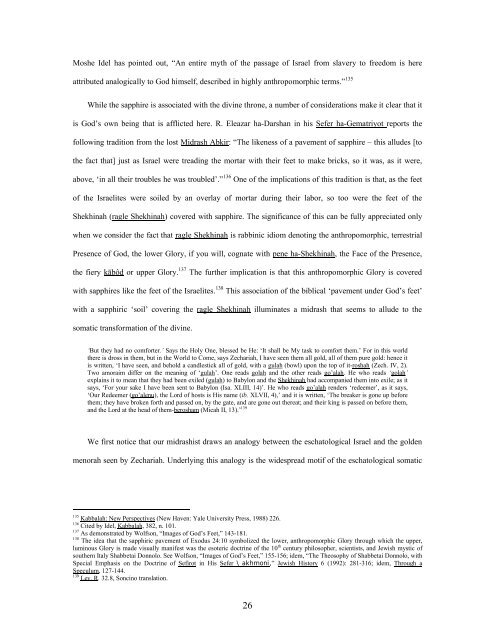Sapphiric God: - Dr. Wesley Muhammad
Sapphiric God: - Dr. Wesley Muhammad
Sapphiric God: - Dr. Wesley Muhammad
Create successful ePaper yourself
Turn your PDF publications into a flip-book with our unique Google optimized e-Paper software.
Moshe Idel has pointed out, “An entire myth of the passage of Israel from slavery to freedom is here<br />
attributed analogically to <strong>God</strong> himself, described in highly anthropomorphic terms.” 135<br />
While the sapphire is associated with the divine throne, a number of considerations make it clear that it<br />
is <strong>God</strong>’s own being that is afflicted here. R. Eleazar ha-Darshan in his Sefer ha-Gematriyot reports the<br />
following tradition from the lost Midrash Abkir: “The likeness of a pavement of sapphire – this alludes [to<br />
the fact that] just as Israel were treading the mortar with their feet to make bricks, so it was, as it were,<br />
above, ‘in all their troubles he was troubled’.” 136 One of the implications of this tradition is that, as the feet<br />
of the Israelites were soiled by an overlay of mortar during their labor, so too were the feet of the<br />
Shekhinah (ragle Shekhinah) covered with sapphire. The significance of this can be fully appreciated only<br />
when we consider the fact that ragle Shekhinah is rabbinic idiom denoting the anthropomorphic, terrestrial<br />
Presence of <strong>God</strong>, the lower Glory, if you will, cognate with pene ha-Shekhinah, the Face of the Presence,<br />
the fiery kābôd or upper Glory. 137 The further implication is that this anthropomorphic Glory is covered<br />
with sapphires like the feet of the Israelites. 138 This association of the biblical ‘pavement under <strong>God</strong>’s feet’<br />
with a sapphiric ‘soil’ covering the ragle Shekhinah illuminates a midrash that seems to allude to the<br />
somatic transformation of the divine.<br />
‘But they had no comforter.’ Says the Holy One, blessed be He: ‘It shall be My task to comfort them.’ For in this world<br />
there is dross in them, but in the World to Come, says Zechariah, I have seen them all gold, all of them pure gold: hence it<br />
is written, ‘I have seen, and behold a candlestick all of gold, with a gulah (bowl) upon the top of it-roshah (Zech. IV, 2).<br />
Two amoraim differ on the meaning of ‘gulah’. One reads golah and the other reads go’alah. He who reads ‘golah’<br />
explains it to mean that they had been exiled (gulah) to Babylon and the Shekhinah had accompanied them into exile; as it<br />
says, ‘For your sake I have been sent to Babylon (Isa. XLIII, 14)’. He who reads go’alah renders ‘redeemer’, as it says,<br />
‘Our Redeemer (go’alenu), the Lord of hosts is His name (ib. XLVII, 4),’ and it is written, ‘The breaker is gone up before<br />
them; they have broken forth and passed on, by the gate, and are gone out thereat; and their king is passed on before them,<br />
and the Lord at the head of them-berosham (Micah II, 13).’ 139<br />
We first notice that our midrashist draws an analogy between the eschatological Israel and the golden<br />
menorah seen by Zechariah. Underlying this analogy is the widespread motif of the eschatological somatic<br />
135 Kabbalah: New Perspectives (New Haven: Yale University Press, 1988) 226.<br />
136 Cited by Idel, Kabbalah, 382, n. 101.<br />
137 As demonstrated by Wolfson, “Images of <strong>God</strong>’s Feet,” 143-181.<br />
138 The idea that the sapphiric pavement of Exodus 24:10 symbolized the lower, anthropomorphic Glory through which the upper,<br />
luminous Glory is made visually manifest was the esoteric doctrine of the 10 th century philosopher, scientists, and Jewish mystic of<br />
southern Italy Shabbetai Donnolo. See Wolfson, “Images of <strong>God</strong>’s Feet,” 155-156; idem, “The Theosophy of Shabbetai Donnolo, with<br />
Special Emphasis on the Doctrine of Sefirot in His Sefer \akhmoni,” Jewish History 6 (1992): 281-316; idem, Through a<br />
Speculum, 127-144.<br />
139 Lev. R. 32.8, Soncino translation.<br />
26
















